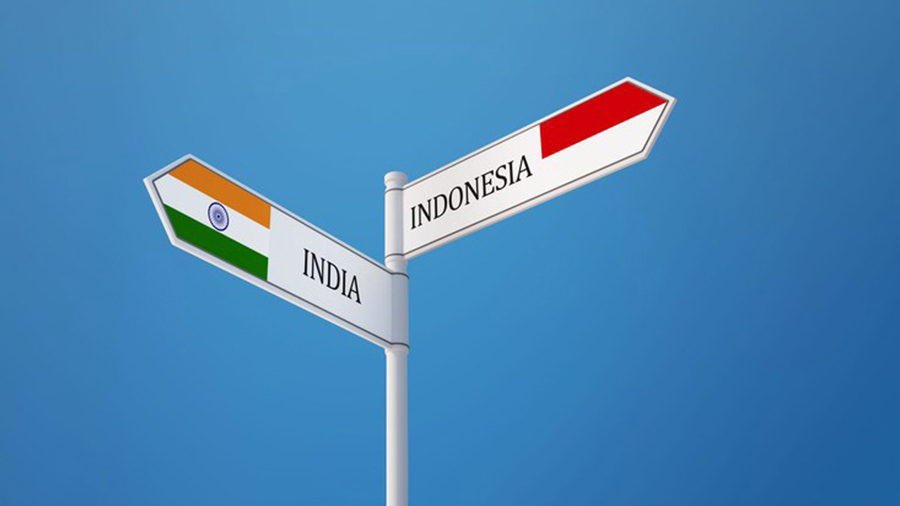
India and Indonesia, connected by a deep-rooted history and strategic partnership, are rapidly advancing their economic cooperation. This includes robust trade ties, increased bilateral investment, and initiatives such as the Economic and Financial Cooperation Dialogue (EFD) to address shared development goals. With a focus on technology, pharmaceuticals, agriculture, and infrastructure, both countries are aiming for a trade target of US$50 billion by 2025. These efforts underscore their commitment to mutual growth, presenting a promising outlook for India-Indonesia trade relations.
India and Indonesia share a deep-rooted historical connection that spans over two millennia, with formal diplomatic relations established in 1951. Their geographical proximity, coupled with a history of collaboration in international forums like the Non-Aligned Movement, has fostered enduring peaceful relations. Over the years, these nations have engaged in defense, political, and parliamentary exchanges, solidifying their partnership.
The strategic alliance between India and Indonesia, forged in 2005, has played a pivotal role in strengthening their ties. India’s foreign policy objectives, geared towards assuming a more prominent global role and competing with major players such as China, have led to a strategic focus on Jakarta. Simultaneously, Indonesia’s foreign policy aligns with its aspirations for development, capital transfer, engagement with global powers, and ambitious infrastructure projects.
In the face of China’s economic slowdown impacting Indonesia’s trade and tourism sectors, India emerges as a promising new market. Both countries have showcased remarkable resilience, navigating challenges and positioning themselves as strategic allies. This shared determination ensures not only mutual growth but also prosperity in the evolving global economic landscape.
Economic collaboration between India and Indonesia
Aligned with their national interests, India and Indonesia are actively seeking opportunities to expedite their development, enhance global influence, promote multilateralism, and strengthen bilateral ties. Noteworthy milestones in their economic collaboration include key events like the Biennial Meeting of Ministers of Trade (2011), the Meeting of CEOs (2013), the Health Cooperation Memorandum (2016), and intensified economic interactions in sectors such as pharmaceuticals and information technology (2018). A significant leap was marked in 2022 with the signing of a Central Bank India-Indonesia mutual agreement (MoU), highlighting the deepening economic ties and mutual commitment to fostering prosperity.
India-Indonesia bilateral trade and investment trends
Trade trends
India and Indonesia initiated their trade relations in 1978 through the signing of trade agreements, followed by the establishment of a double taxation avoidance agreement in January 1986. The Indo-Indonesia Joint Commission (JCM) was formed in September 2003, and the Double Taxation Avoidance Agreement (DTAA) was endorsed in 2012. Specialized working groups were created to further strengthen their economic and commercial ties. Both nations have set an ambitious goal of achieving US$50 billion in bilateral trade by 2025, as part of their broader strategic partnership and their collective efforts to access the Comprehensive Economic Cooperation Agreement (CECA).
Remarkably, in 2021, the total value of trade between Indonesia and India witnessed a remarkable increase of 48.48 percent. This positive momentum continued into 2022, with a further uptick in trade volume. Bilateral trade between India and Indonesia has been on a significant upward trajectory, predominantly due to the India-ASEAN Free Trade Agreement (FTA). In fact, trade between these two countries has surged eightfold since 2005, reaching a substantial US$38 billion in the financial year (FY) 2023.
Exports from India to Indonesia
India exported a diverse range of 4,165 commodities to Indonesia in FY 2023. Leading exports from India to Indonesia included petroleum products (US$3.87 billion), motor vehicles and cars (US$523 million), sugar (US$435 million), ships, boats, and floating structures (US$400 million), and iron and steel (US$389 million).
Imports from Indonesia to India
India imported 2,221 commodities from Indonesia in FY 2023. Key imports from Indonesia to India consisted of coal, coke, and briquettes (US$14.58 billion), vegetable oils (US$5.63 billion), iron and steel (US$1.59 billion), bulk minerals and ores (US$969 million), and cosmetics and toiletries (US$632 million).
Strategic partnership
Indonesia holds a crucial economic position for India, serving as the largest trading partner in ASEAN. India, in turn, ranks as the fourth largest export destination for Indonesia. There remains substantial untapped potential for expanding trade in various sectors, including agriculture, pharmaceuticals, automobiles, engineering, information technology, and biotechnology.
Indonesian investment in India
India’s robust economic growth, status as the world’s most populous nation, rank as the fifth-largest global economy, impending approach to a US$5 trillion economy, technological advancements, a thriving startup ecosystem, and a diversified industrial landscape have piqued Jakarta’s keen interest in the Indian market.
While Indonesian investment in India remains relatively modest, standing at about US$647 million, Indonesian companies have started establishing their presence in various sectors.
Among the Indonesian companies operating in India, seven are engaged in agriculture and food, while others are active in diverse sectors such as highways, airports, oil refineries, infrastructure, banking, and transportation. Indonesia holds the 33rd position in terms of foreign direct investment (FDI) inflows to India during the period spanning April 2000 to March 2023.
Indian investment in Indonesia
India’s investment in Indonesia stands at US$54 billion, primarily channeled through Singapore, with Indian companies like Tata Power, Reliance, Adani, and L&T making significant investments in various sectors, including infrastructure, power, textiles, steel, automotive, mining, machinery, banking, and consumer goods.
Indo-Pacific Economic Framework (IPEF), presents a dynamic outlook for future trade.
Crucially, factors such as India’s robust GDP growth, a youthful population in comparison to China, ongoing structural reforms, expectations of increased FDI, and rapid digitalization efforts have the potential to further enhance trade prospects. The economic ties between India and Indonesia have diversified significantly, and efforts to expand trade into new sectors through mutually beneficial cooperation are underway.
This diversity and collaboration not only align with India’s aspirations to become the world’s third-largest economy by 2027 but also resonate with Indonesia’s vision for 2045, aiming for the fifth position in the global economy. With this shared ambition and the ongoing joint efforts, the trade relations between India and Indonesia have the potential to escalate significantly, possibly reaching an impressive US$50 billion in the coming years.
Source: India Briefing
Share: